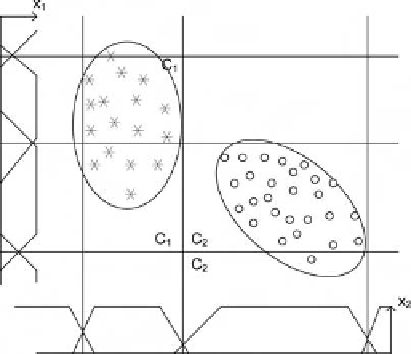Image Processing Reference
In-Depth Information
For this strategy we can also introduce the concept of weighted input pat-
terns presented already in Section 6.3.1. The weight would be interpreted
as degree of belief to the usefulness of each data pair from training data set.
Suppose that for every input-output pattern we can assign a weight ω then
we have:
SD(R
j
) = [µ(x
(1)
)(v = C)·. . .·µ(x
(n)
j
)(v = C)]·µ(x
j
)(v = C)ω
(6.36)
j
This strategy gives good results even when a small number of training sam-
ples is available.
FIGURE 6.6: Example of two clusters and the corresponding rule bank in two-dimensional
space
After the minimisation of fuzzy rules we create a rule bank which later will be used for
classification. The form of the rule bank for a 2-dimensional feature space with 2 clusters
is shown in Fig. 6.6. The boxes of the bank are filled with fuzzy rules originating either
from the numerical data or from linguistic rules given by the expert. For conjunction AND
defined between two features only one box of the rule bank is filled. For OR relations all
the boxes are filled that are in the rows or columns corresponding to the regions of the
antecedent IF part.
To determine the mapping (Eq. 6.1) in fuzzy systems, a deffuzification method needs
to be adopted. The deffuzification problem defines the strategy of using the fuzzy result
given by degree values Eq. 6.4 and Eq.6.5 to guide us in the selection of one representative
element (class) of the setC.
6.4
Applications
To demonstrate the applicability of the ideas described in this chapter we present a few ap-
plications of fuzzy If-Then rule-based systems in medical image understanding. We present
computer-aided diagnosis systems for breast cancer diagnosis (Section 6.4.1) and thermog-
raphy (Section 6.4.2) where the idea of weighted fuzzy classifier with integrated learning




Search WWH ::

Custom Search